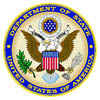| United States Embassy Tokyo, Japan |
 |
||
| Welcome to the U.S. Embassy in Tokyo. This site contains information on U.S. policy, public affairs, visas and consular services. |
|
|
||||||||||||||||||||||||||||||
|
Action implements CITES agreement to promote sustainable harvest
A U.S. government agency has announced implementation of international rules regulating imports of endangered species of mahogany.
In a November 26 press release, the U.S. Fish and Wildlife Service said the United States, one of the world's biggest importers of mahogany, would require permits for imports and re-export of certain mahogany logs, sawn wood, veneer sheets and plywood in line with Convention on International Trade in Endangered Species (CITES) rules.
Covered by the regulation are imports of three species of mahogany -- bigleaf mahogany (Swietenia macrophylla), Pacific coast mahogany (S. humilis), and Caribbean mahogany (S. mahagoni) -- and only those from their native range, not those from plantations outside that range.
Following is the text of the press release
The U.S. Fish and Wildlife Service announced, effective November 15, 2003, it is implementing new international permit requirements to regulate trade in neotropical bigleaf mahogany under the Convention on International Trade in Endangered Species (CITES). Valid CITES import and re-export permits are now required for logs, sawn wood, veneer sheets, and plywood. Permits are not needed for other parts, derivatives or products.
Last year the 160 CITES member nations decided to list the species on Appendix II of the Convention on International Trade in Endangered Species of Wild Fauna and Flora (CITES) to help ensure that harvest is legal and trade sustainable.
"As one of the world's leading importers of mahogany, the U.S. is 100 percent behind this new conservation effort," said Service Director Steve Williams. "Valued for its beauty and durability, we want to make certain people everywhere can enjoy mahogany products for generations to come."
There are three species of neotropical mahogany: bigleaf mahogany (Swietenia macrophylla), Pacific coast mahogany (S. humilis), and Caribbean mahogany (S. mahagoni). Mahogany occurs in lowland tropical or subtropical forests. A strong, hard wood with a red hue and fine grain pattern, it is ideal for use in furniture, doors, paneling, musical instruments, ships, caskets, veneer, and plywood. Due to strong demand for the wood of these relatively slow-growing trees, all three species are listed in CITES.
The listing of bigleaf mahogany includes only populations within the native range of the species. Bigleaf mahogany grown on plantations outside of its native range is not regulated under CITES. Neotropical mahogany should not be confused with other tree species with reddish wood that are commonly called "mahogany." Philippine mahogany is a name given to some of the different species of Shorea that grow in the Philippines, Malaysia, and Indonesia. African mahogany refers to several species of Khaya that grow throughout West Africa. Santos mahogany (Myroxylon balsamum) ranges from southern Mexico to Argentina. None of these "mahoganies" are listed in the CITES Appendices.
For more information on mahogany, please visit this site online.
The U.S. Fish and Wildlife Service is the principal federal agency responsible for conserving, protecting and enhancing fish, wildlife and plants and their habitats for the continuing benefit of the American people. The Service manages the 95 million acre National Wildlife Refuge System, which encompasses 542 national wildlife refuges, thousands of small wetlands and other special management areas. It also operates 69 national fish hatcheries, 64 fishery resource offices and 78 ecological services field stations. The agency enforces federal wildlife laws, administers the Endangered Species Act, manages migratory bird populations, restores nationally significant fisheries, conserves and restores wildlife habitat such as wetlands, and helps foreign governments with their conservation efforts. It also oversees the Federal Aid program that distributes hundreds of millions of dollars in excise taxes on fishing and hunting equipment to state fish and wildlife agencies.
For more information on the Fish and Wildlife Service, see our Web site at www.fws.gov.
This site is produced and maintained by the Public Affairs Section of the U.S. Embassy, Japan. Links to other Internet sites should not be construed as an endorsement of the views contained therein.